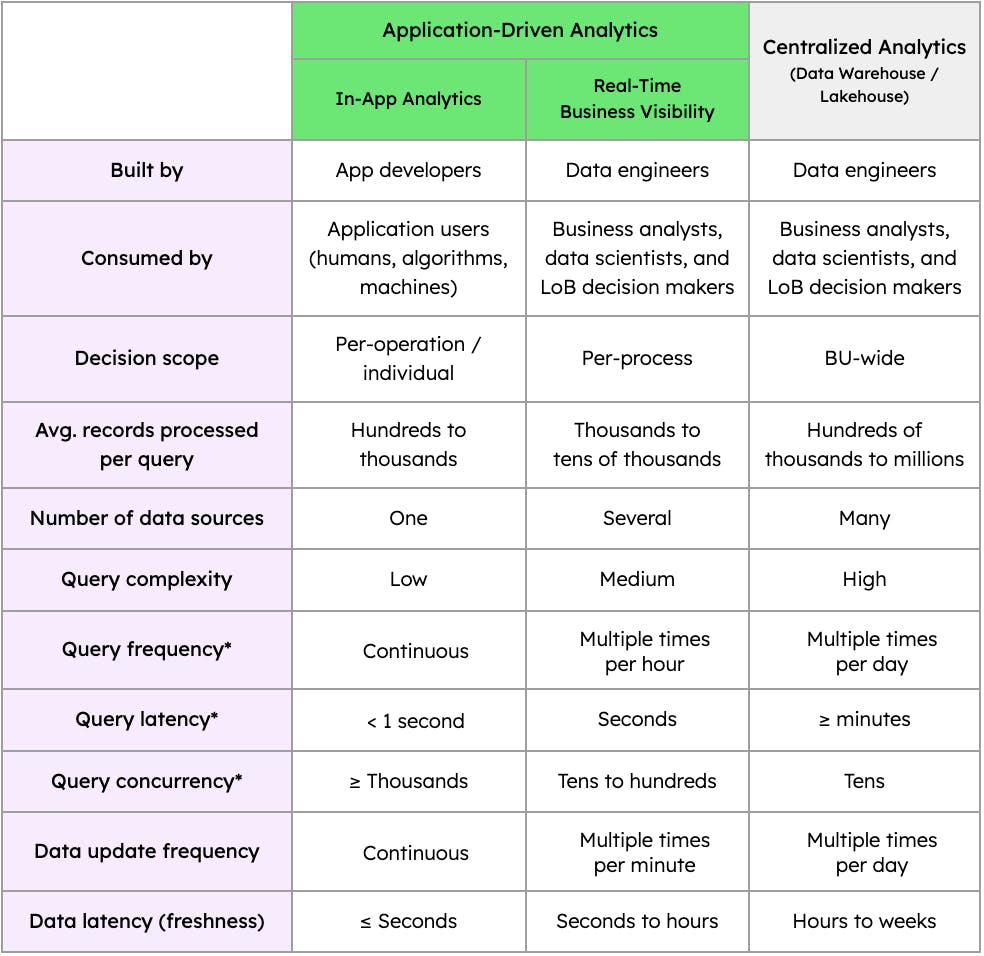Choosing the Right Tool for the Job: Understanding the Analytics Spectrum
_Thunbnail.png?auto=format%252Ccompress)
Data-driven organizations share a common desire to get more value out of the data they're generating. To maximize that value, many of them are asking the same or similar questions:
-
How long does it take to get analytics and insights from our application data?
-
What would be the business impact if we could make that process faster? What new experiences could we create by having analytics integrated directly within our customer-facing apps?
-
How do our developers access the tools and APIs they need to build sophisticated analytics queries directly into their application code?
-
How do we make sense of voluminous streams of time-series data?
We believe the answer to these questions in today's digital economy is application-driven analytics.
What is Application-Driven Analytics?
Traditionally, there's been a separation at organizations between applications that run the business and analytics that manage the business. They're built by different teams, they serve different audiences, and the data itself is replicated and stored in different systems.
There are benefits to the traditional way of doing things and it's not going away. However, in today's digital economy, where the need to create competitive advantage and reduce costs and risk are paramount, organizations will continue to innovate upon the traditional model.
Today, those needs manifest themselves in the demand for smarter applications that drive better customer experiences and surface insights to initiate intelligent actions automatically. This all happens within the flow of the application on live, operational data in real time. Alongside those applications, the business also wants faster insights so it can see what's happening, when it's happening. This is known as business visibility, and the goal of it is to increase efficiency by enabling faster decisions on fresher data. In-app analytics and real-time visibility are enabled by what we call application-driven analytics.
You can find examples of application-driven analytics in multiple real-world industry use cases including:
-
Hyper-personalization in retail
-
Fraud prevention in financial services
-
Preventative maintenance in manufacturing
-
Single subscriber view in telecommunications
-
Fitness tracking in healthcare
-
A/B testing in gaming
Where Application-Driven Analytics fits in the Analytics Ecosystem
Application-driven analytics complements existing analytics processes where data is moved out of operational systems into centralized data warehouses and data lakes. In no way does it replace them. However, a broader spectrum of capabilities are now required to meet more demanding business requirements.
Contrasting the two approaches, application-driven analytics is designed to continuously query data in your operational systems. The freshest data comes in from the application serving many concurrent users at very low latency. It involves working on much smaller subsets of data compared to centralized analytics systems. Application-driven analytics is typically working with hundreds to possibly a few thousand records at a time. And it's running less complex queries against that data.
At the other end of the spectrum is centralized analytics. These systems are running much more complex queries across massive data sets — hundreds of thousands or maybe millions of records, and maybe at petabyte scale — that have been ingested from many different operational data sources across the organization.
Table 1 below identifies the required capabilities across the spectrum of different classes of analytics. These are designed to help MongoDB’s customers match appropriate technologies and skill sets to each business use case they are building for.

By mapping required capabilities to use cases, you can see how these different classes of analytics serve different purposes. If, for example, we're dealing with recommendations in an e-commerce platform, the centralized data warehouse or data lake will regularly analyze vast troves of first- and third-party customer data. This analysis is then blended with available inventory to create a set of potential customer offers.
These offers are then loaded back into operational systems where application-driven analytics is used to decide which offers are most relevant to the customer based on a set of real-time criteria, such as actual stock availability and which items a shopper might already have in their basket. This real-time decision-making is important because you wouldn't want to serve an offer on a product that can no longer be fulfilled or on an item a customer has already decided to buy. This example demonstrates why it is essential to choose the right tool for the job. Specifically, in order to build a portfolio of potential offers, the centralized data warehouse or data lake is an ideal fit. Such technologies can process hundreds of TBs of customer records and order data in a single query.
The same technologies, however, are completely inappropriate when it comes to serving those offers to customers in real time. Centralized analytics systems are not designed to serve thousands of concurrent user sessions. Nor can they access real-time inventory or basket data in order to make low latency decisions in milliseconds. Instead, for these scenarios, application-driven analytics served from an operational system is the right technology fit.
As we can see, application-driven analytics is complementary to traditional centralized analytics, and in no way competitive to it.
The benefits to organizations of using these complementary classes of analytics include:
-
Maximizing competitive advantage through smarter and more intelligent applications
-
Out-innovating and differentiating in the market
-
Improving customer experience and loyalty
-
Reducing cost by improving business visibility and efficiency
Through its design, MongoDB Atlas unifies the essential data services needed to deliver on application-driven analytics. It gives developers the tools, tech, and skills they need to infuse analytics into their apps. At the same time, Atlas provides business analysts, data scientists, and data engineers direct access to live data using their regular tools without impacting the app.
For more information about how to implement app-driven analytics and how the MongoDB modern database gives you the tools needed to succeed, download our white paper, Application-Driven Analytics: Defining the Next Wave of Modern Apps.